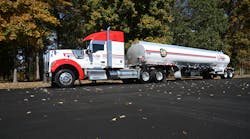TRUCK DRIVERS (especially those in over-the-road operations) often spend long periods of time sitting and driving. On top of that, the average truck driver consumes more than 4,000 calories a day.
It is a lifestyle that contributes to a wide range of health issues, including sleep apnea, high blood pressure, and diabetes. Bob Perry president and founder of Rolling Strong addressed the driver lifestyle issues and what needs to be changed in driver wellness presentation during the National Tank Truck Carriers Tank Truck Safety & Security Council Seminar that was held June 4-6 in Denver, Colorado.
“I come from a long line of professional truck drivers,” Perry said. “My brother currently drives a truck for Liquid Transport (Corp). My father drove for 50 years and retired with the full professional truck driver health package—sleep apnea, high blood pressure, and high sugar levels. It cut short his life.
“My mission is very simple. I want to deliver solutions to help truck drivers take better care of themselves and get home safely to their families after every trip. It’s time to rethink the way we view safety and include driver wellness as part of the program.”
Safety connection
Risk management, carrier benefits programs, and fleet safety are more connected to driver personal health than ever before. “A driver can’t be safe if he isn’t feeling well,” he said. “Drivers need to care for themselves just like they do their trucks.”
Perry said he believes wellness programs not only contribute to fleet safety, they also help a carrier stand out from the crowd as a more attractive place to work. That’s important because it is becoming much more difficult to find enough good drivers.
Demographics are changing, and fleets are faced with locating new sources of drivers. The growing driver shortage is exacerbated by the steadily growing regulatory burden and the challenges posed by the Compliance, Safety, Accountability (CSA) program.
Perry described the experience of one trucking company client: In 2011, that client recorded 33 blood failures among drivers, representing 3.6% of total health-related disqualifications for the year. Following implementation of a wellness program, the fleet cut disqualifications to just 12 (1.1% of total hires). Based on an average cost of $8,000 to hire and train each new driver, the fleet saved approximately $168,000 with the wellness program.
Perry cited an 80-driver study showing the benefits that can be achieved with a fleet wellness program. Drivers saw roughly a 24% drop in weight over a 12-month period. Body mass dropped 14%. Average blood pressure fell from 138/90 to 129/82. Cholesterol levels were reduced 16% in 90 days from 167 to 140. Glucose levels fell 11% in 90 days from 139 to 124.
Top down
Building an effective driver wellness program starts at the top. It must have executive support to succeed. Fleets must be willing to make the necessary financial investment and make changes in the corporate culture.
A wellness program must have an assessment component that will make it possible to identify individuals who could benefit from treatment for a condition they are unaware that they have, according to Perry. The program needs to educate and inform to prevent further disability among individuals with an established disease. It should recommend lifestyle changes that can improve an individual’s health with tools he can use while on the road and at home. Finally, drivers should be rewarded for reaching health milestones.
Reaching truck drivers at multiple touch points is the key to success, Perry said. Drivers that are part of the Rolling Strong program carry a wellness card that gives access to Rolling Strong Wellness Stations at Pilot Flying J Travel Centers, Kroger grocery stores, and other locations. The stations make it easy to check a driver’s weight, body mass index, body fat, heart rate, blood pressure, vision, and hydration.
Perry’s Rolling Strong program includes Rebuilt, a 30-day bootcamp that combines exercise and health education. “We show drivers how to shop for healthy food,” he said. “Drivers—men and women—who go through this program are losing weight.”
FIT System is a program developed with Freightliner that puts an exercise system in sleeper-equipped Freightliner tractors. Rolling Strong also has an agreement with Snap Fitness 24-7 that gives truck drivers access to more than 1,300 gyms across the United States.
The program uses a number of techniques to constantly remind drivers of two key wellness elements: movement and what they eat and drink. For instance, signs in driver lounges at fleet terminals and truck stops remind drivers that cold water burns five calories while a 12-ounce soda adds 150 calories and 40 grams of sugar.
“To burn off those extra calories will require a brisk walk for 42 minutes or a 17-minute run,” Perry says. “The average driver consumes over 4,000 calories a day. We work a lot with drivers on portion control, and we are promoting better snacks in driver lounges and truck stops.” ♦











